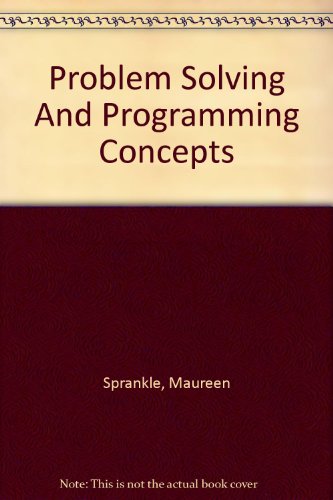
Synopsis
Ideal for novice and experienced programmers alike, this book shows readers how problem solving is the same in all computer languages—regardless of syntax. Using a step-by-step, generic, non-language-specific approach—with detailed explanations and many illustrations—it presents the tools and concepts required when using any programming language to develop computer applications. The focus throughout is on the use of problem solving tools—including problem analysis charts, interactivity (structure) charts, IPO charts, coupling diagrams, algorithms, flowcharts, and (in appendices) Universal Modeling Languages concepts, Nassi-Schneiderman charts, and Warnier-Orr diagrams. Techniques are detailed for applications such as page layout, spreadsheets, database management systems, and document processing, and Putting It All Together sections show readers how to put individual problem-solving techniques together into viable strategies for tackling specific kinds of problems/applications. General Problem Solving Concepts. Programming Concepts. Problem Solving with the Sequential Logic Structure; with Decisions; with Loops; with the Case Logic Structure. Processing Arrays. Data Structures. Database Concepts. Concepts of Object Oriented Programming. Object Oriented Program Design. File Concepts. Sequential-Access File Applications. Sequential-Access File Updating. Random Access File Processing and Updating. Problem Solving for Word Processing and Desktop Publishing; for Spreadsheets; for Document Processing.
"synopsis" may belong to another edition of this title.
From the Back Cover
This text covers the basic problem-solving concepts that readers need to know and understand when working in any computer language or application. With detailed explanations and numerous illustrations, it encompasses all fundamental areas of problem solving from the basics of mathematical functions and operators to the design and use of codes, indicators, control breaks, arrays, pointers, file updates, and report handling. Problem-solving tools, including problem analysis charts, interactive charts, IPO charts, algorithms, and flowcharts are used to design a solution to a problem.
This edition is divided into six parts, organized as follows:Unit 1, Introduction to Problem Solving and Programming—Problem solving, an introduction to how problems are solved on computers, mathematical concepts, and steps for analyzing a problem and designing an appropriate solution
Unit 2, Programming Logic Structure—Programming that includes local and global variables, parameters, and sequential, decision, loop, and case logic structures
Unit 3, Data Structures—Arrays, sorting techniques, search methods, stacks, linked lists, binary trees, and databases
Unit 4, Object-Oriented ProgrammingDesign of a solution using object-oriented languages
Unit 5, File Processing—File concepts, sequential file processing, and random access file processing
Unit 6, Problem Solving for Application Software—Word processing, design, spreadsheets, and information processing
Excerpt. © Reprinted by permission. All rights reserved.
Knowledge of problem solving and programming concepts is necessary for those who develop applications for users. Unfortunately, many students have greater difficulty with problem solving than they do with the syntax of computer languages. The art of programming is learning multiple techniques and applying those techniques to specific problems. When students learn basic programming and problem-solving techniques, they can then concentrate on the syntax when learning specific languages. These techniques may be presented in a separate class on problem solving or with a first language course that concentrates on problem solving. This approach tends to decrease students' frustration and improves their success rates.
This book is intended for a one-semester introductory course for programming majors. It can serve as a primary text or as a supplement. Although this book is written for students who have little or no computer experience, those who have studied a computer language can benefit from the generic presentation of the material.
The text provides a step-by-step progression of ideas with detailed explanation and many illustrations, from the basics of mathematical functions and operators to the design and use of techniques such as codes, arrays, pointers, other data structures, database concepts, and object-oriented programming concepts. The text uses problem-solving tools including problem analysis charts, interactivity charts, IPO charts, algorithms, and flowcharts to design a solution to a problem. The appendices present additional tools, including Universal Modeling Languages concepts, Nassi-Schneiderman charts, and Warnier-Off diagrams. Putting It All Together sections illustrate a complete solution for a given problem, using the concepts previously presented. In some cases, an earlier solution is updated to incorporate more sophisticated techniques. Throughout the text, problems presented for solution are typical of the business world and provide excellent experience for students. These problems can then be presented in a language course so that students can finish the solution on the computer.
Organization of This Text
Unit One, Introduction to Problem Solving and Programming, presents basic concepts of problem solving, an introduction to how problems are solved on computers, mathematical concepts required for problem solving using a computer, and steps for analyzing a problem and designing an appropriate solution. Unit Two, Logic Structures, presents basic concepts of programming, including local and global variables, parameters, and four basic logic structures. The four basic logic structures are sequential, decision, loop, and case logic structures. Unit Two presents programming techniques using these programming logic structures. Unit Three, Data Structures, presents the concepts of arrays, sorting techniques, search methods, stacks, linked lists, binary trees, and databases. Unit Four, Object-Oriented Programming, presents basic concepts in the design of a solution using object-oriented languages. Unit Five, File Processing is extremely important for a COBOL student. Database tools are replacing traditional techniques of working with large amounts of data. However, there are still many COBOL programs in government and industry that are being maintained. Unit Six, Problem Solving for Application Software, is presented for the programmer who will be using these applications to write reports and create budgets and who will need to combine applications to create a document or presentation of a problem. The unit presents concepts of word processing, design, spreadsheets, and information processing. Appendixes present formulas commonly used in business, sort and merge methods, ASCII and EBCDIC codes, blank forms, other problem-solving tools, and concepts of UML.
"About this title" may belong to another edition of this title.

